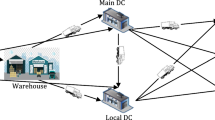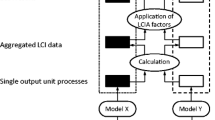Abstract
Goal, Scope and Background
The eco-efficiency analysis and portfolio is a powerful decision support tool for various strategic and marketing issues. Since its original academic development, the approach has been refined during the last decade and applied to a multitude of projects. BASF, as possibly the most prominent company using and developing this tool, has applied the eco-efficiency approach to more than 300 projects in the last 7 years. One of the greatest difficulties is to cover both dimensions of eco-efficiency (costs or value added and environmental impact) in a comparable manner. This is particularly a challenge for the eco-efficiency analyses of products.
Methods
In this publication, an important approach and field of application dealing with product decisions based on the combination of Life Cycle Cost (LCC) and Life Cycle Assessment (LCA) is described in detail. Special emphasis is put on the quantitative assessment of the relation of costs and environmental impacts. In conventional LCA an assessment of environmental impact categories is often made by normalization with inhabitant equivalents. This is necessary to be able to compare the different environmental impact categories, because of each different unit. For the proposed eco-efficiency analysis, the costs of products or processes are also normalized with adapted gross domestic product figures.
Results and Discussion
The ratio between normalized environmental impact categories and normalized costs (RE,C) is used for the graphical presentation of the results in an eco-efficiency portfolio. For the interpretation of the results of an eco-efficiency analysis, it is important to distinguish ratios RE,C which are higher than one from ratios lower than one. In the first case, the environmental impact is higher than the cost impact, while the inverse is true in the second case. This is very important for defining which kind of improvement is needed and defining strategic management decisions. The paper shows a statistical evaluation of the RE,C factor based on the results of different eco-efficiency analyses made by BASF. For industries based on large material flows (e.g. chemicals, steel, metals, agriculture), the RE,C factor is typically higher than one.
Conclusions and Recommendations
This contribution shows that LCC and LCA may be combined in a way that they mirror the concept of eco-efficiency. LCAs that do not consider LCC may be of very limited use for company management. For that very reason, corporations should install a data management system that ensures equal information on both sides of the eco-efficiency coin.
Similar content being viewed by others
References
Schaltegger S, Sturm A (1990): Ökologische Rationalität. Die Unternehmung 4, 273–290
Schmidheiny S with the Business Council for Sustainable Development (BCSD) (1992): Changing course: A global business perspective on development and the environment. MIT Press, Cambridge, MA
WBCSD (World Business Council for Sustainable Development) (2000): Measuring eco-efficiency. A guide to reporting company performance. WBCSD, Geneva
Schaltegger S, Sturm A (1992): Erfolgskriterien ökologieorientierten Managements. ZfU 15(2) 131–154
Schaltegger S, Sturm A (1998): Eco-Efficiency by Eco-Controlling. On the implementation of EMAS and ISO 14001. Hochschulverlag, Zurich
Frankl P (2001): Life cycle assessment as a management tool, INSEAD Working Paper 2001/92/CMER. INSEAD, Fontainbleau
Schaltegger S, Burritt R (2000): Contemporary Environmental Accounting. Issues, Concepts and Practice. Greenleaf, Sheffield
Saling P, Kicherer A, Dittrich-Krämer B, Wittlinger R, Zombik W, Schmidt I, Schrott W, Schmidt S (2002): Eco-efficiency Analysis by BASF. The method. Int. J LCA 7(4) 203–218
European Environmental Agency (EEA) (eds) (1997): Life Cycle Assessment. A guide to approaches, experiences and information sources. Environmental Issues Series No. 6. EEA, Copenhagen
Erlandsson M, Lindfors L-G (2003): On the Possibilities to Apply the Result from an LCA Disclosed to Public. Int J LCA 8(2) 65–73
Tolle DA (1997): Regional Scaling and Normalization in LCIA. Int J LCA 2(4) 197–208
Olsthoorn X, Tyteca D, Wehrmeyer W, Wagner M (2001): Environmental indicators for business: A review of the literature and standardisation methods. J Cleaner Production 9, 453–463
Schaltegger S (1997): Economics of Life Cycle Assessment (LCA). Inefficiency of the Pre-sent Approach. Business Strategy and the Environment 6(4) February, 1–8
Schaltegger S, Kubat R, Hilber C, Vaterlaus S (1996): Innovatives Management staatlicher Umweltpolitik. Das Konzept des New Public Environmental Management (NPEM). Birkhäuser, Basel, Boston
International Standard Organisation (ISO) (eds): Environmental management — Life cycle assessment — ISO 14040 (1997); 14041 (1998); 1402 (2000); 14043 (2000)
Ministerie van Volkshuisvesting, Ruimtelijke Ordening en Milieubeherr (VROM), Centrum voor Milieukunde (CML) (eds) (2001): Levenscyclusanalyse. De ISO-normen uitgewerkt in een praktijkgerichte Handleiding. VROM, Den Haag
Rebitzer G (2002): Integrating Life Cycle Costing and Life Cycle Assessment. In: Seuring S (ed), Cost Management in supply chains. Physica, Heidelberg, pp 127–146
Klöpffer W (2003): Life-Cycle Based Methods for Sustainable Product Development. Editorial for the LCM Section. Int J LCA 8(3) 157–159
Guinée J (ed) (2002): Handbook in Life Cycle Assessment. Operational Guide to the ISO Standards. Kluwer Academic, Dordrecht
Sundmacher T (2002): Das Umweltinformationsinstrument Ökobilanz (LCA): Anwendungsbezug und instrumentelle Ausgestaltungsmöglichkeiten. Verlag Lang, Frankfurt, 322 pp
Goedkoop M, Spriensma R (2001): The Eco-indicator 99. A damage oriented method for Life Cycle Assessment. Methodology Report. 3rd edition, PRé Consultants, Amersfoort
Reich M C (2005): Economic assessment of municipal waste management systems — Case studies using a combination of life cycle assessment (LCA) and life cycle costing (LCC). J Cl Prod 13, 253–263
Bouman M, Heijungs R, van der Voet E, van den Bergh JCJM, Huppes G (2000): Material flows and economic models: An analytical comparison of SFA, LCA and partial equilibrium models. Ecological Economics 32(2) 195–216
Faßbender-Wynands E (2003): Lebenszyklusrechnung als Instrument des umweltorientierten Kostenmanagements. In: Wagner S, Kupp M, Matzel M (eds), Quantitative Modelle und nachhaltige Ansätze der Unternehmensführung. Physica, Heidelberg, pp 133–148
Statistisches Bundesamt (2002): Statistisches Jahrbuch 2002 für die Bundesrepublik Deutschland
Author information
Authors and Affiliations
Corresponding authors
Rights and permissions
About this article
Cite this article
Kicherer, A., Schaltegger, S., Tschochohei, H. et al. Eco-efficiency. Int J Life Cycle Assess 12, 537–543 (2007). https://doi.org/10.1065/lca2007.01.305
Received:
Accepted:
Published:
Issue Date:
DOI: https://doi.org/10.1065/lca2007.01.305




